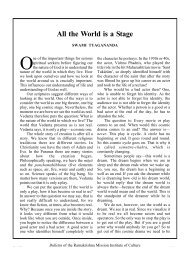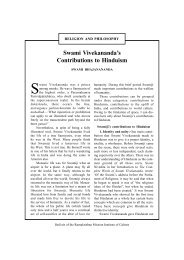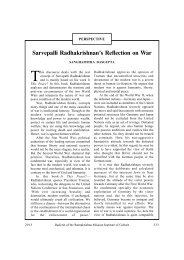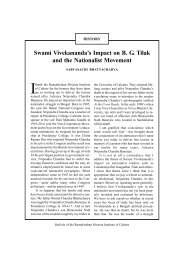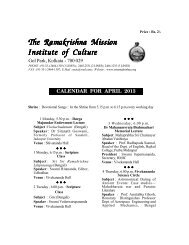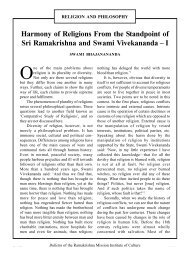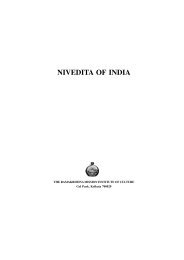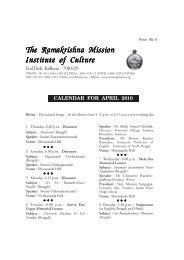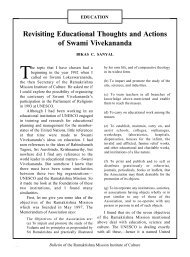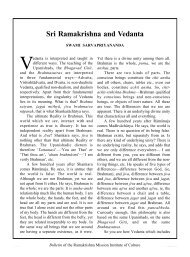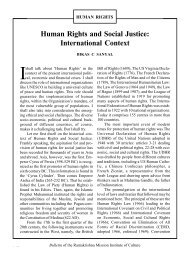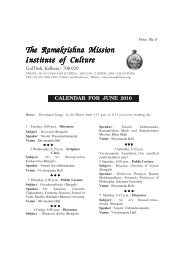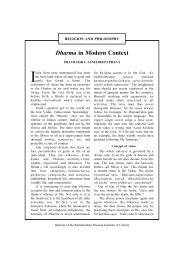The Vitality of India - Ramakrishna Mission Institute of Culture
The Vitality of India - Ramakrishna Mission Institute of Culture
The Vitality of India - Ramakrishna Mission Institute of Culture
Create successful ePaper yourself
Turn your PDF publications into a flip-book with our unique Google optimized e-Paper software.
THE VITALITY OF INDIA<br />
<strong>The</strong> <strong>Vitality</strong> <strong>of</strong> <strong>India</strong><br />
INDRA NATH CHOUDHURI<br />
<strong>The</strong> disintegration <strong>of</strong> the Soviet Union<br />
and end <strong>of</strong> the Cold War and also the<br />
achievement <strong>of</strong> the self-sustaining<br />
growth under private ownership and partial<br />
rejection <strong>of</strong> the Marxian ideology by the<br />
People’s Republic <strong>of</strong> China have made any<br />
discussion on ideologies or acceptance <strong>of</strong> any<br />
<strong>of</strong> them for the development <strong>of</strong> a country<br />
irrelevant. On the other side, one can see the<br />
urge <strong>of</strong> different nation-states to search for,<br />
and to discover and apply their vitality, pràna<br />
shakti or the inner strength rooted in their<br />
culture as a practical philosophy for their<br />
growth and development.<br />
<strong>The</strong> sweeping tide <strong>of</strong> globalization in the<br />
postmodernist period has also led people to<br />
search for their identities and roots and also<br />
their ethnicity to ward <strong>of</strong>f the co-opting,<br />
homogenizing or appropriating tendencies <strong>of</strong><br />
the global market. All these, such as assertion<br />
<strong>of</strong> a separate identity, are possible only by<br />
rediscovering the vitality <strong>of</strong> a nation. Asserting<br />
separate identity does not mean breeding<br />
fascism or showing totalitarian tendencies or<br />
exclusiveness. It only means that if one<br />
knows oneself, one’s own identities, one’s<br />
kendra, then it becomes easy for one to harmoniously<br />
blend together the various strands<br />
<strong>of</strong> thoughts <strong>of</strong> a multiracial, multireligious,<br />
multicultural and multilingual country like<br />
<strong>India</strong>. Assertion <strong>of</strong> one’s identity in a monocultural<br />
state can be problematic as one can<br />
see that in monocultural states in Europe and<br />
America where after the 9/11 destruction <strong>of</strong><br />
the twin towers in New York every Muslim<br />
has become a suspect and where the goals are<br />
now set on the principle <strong>of</strong> an eye for an eye<br />
and, in the process, great harm and destruction<br />
have taken place in today’s world to the<br />
human lives and cultures <strong>of</strong> various nations.<br />
In a state like <strong>India</strong>, affirmation <strong>of</strong> one’s identity,<br />
in fact, helps in creating a landscape <strong>of</strong><br />
harmony, <strong>of</strong> democracy and freedom and <strong>of</strong><br />
tolerance, solidarity and dialogue because<br />
<strong>India</strong>’s great diversity, its pluralistic<br />
worldview and its multicultural and<br />
multireligious reality form the basis <strong>of</strong><br />
<strong>India</strong>’s identity. A search for <strong>India</strong>’s identity<br />
is, in fact, a search for <strong>India</strong>nness or, in other<br />
words, a search for its vitality and as a consequence<br />
the issue <strong>of</strong> the vitality <strong>of</strong> <strong>India</strong> turns<br />
into a search for all those dimensions which<br />
together constitute and define the vitality or<br />
the inner strength <strong>of</strong> <strong>India</strong> to be found in its<br />
ancient civilization, universal ethical values,<br />
pluralistic traditions, in its stable democracy<br />
and in the message <strong>of</strong> satya and ahimsà by<br />
Gandhi and in the unification <strong>of</strong> tradition<br />
with modernity by Tagore and in the adoption<br />
<strong>of</strong> internationalism by Nehru.<br />
<strong>Culture</strong>, philosophy and spiritualism<br />
<strong>The</strong> vitality though largely inward-bound<br />
had multifaceted expressions which looked at<br />
life in its totality—the material, the supramental<br />
and the spiritual and hence one can<br />
find <strong>India</strong>’s vitality rooted in its culture,<br />
philosophy and spiritualism.<br />
Others may locate <strong>India</strong>’s vitality in its<br />
plurality and diversity operating in an ambience<br />
<strong>of</strong> inclusiveness.<br />
Democracy and the common man<br />
<strong>The</strong>n there are many others who uncover<br />
<strong>India</strong>’s vitality in the vibrancy <strong>of</strong> its democracy<br />
where the wisdom <strong>of</strong> the common man<br />
2011 Bulletin <strong>of</strong> the <strong>Ramakrishna</strong> <strong>Mission</strong> <strong>Institute</strong> <strong>of</strong> <strong>Culture</strong><br />
381
INDRA NATH CHOUDHURI<br />
in making the correct political choice is well<br />
known and at the same time so much admired<br />
and applauded.<br />
Can I draw your kind attention to the<br />
sacred images <strong>of</strong> Sri <strong>Ramakrishna</strong><br />
Paramahamsa and Swami Vivekananda<br />
which we all have so solemnly stored in the<br />
inner sanctum <strong>of</strong> our minds. In the images Sri<br />
<strong>Ramakrishna</strong> is always found to be wearing<br />
the dress <strong>of</strong> the common man and looking so<br />
humble but at the same time spiritually so<br />
much enlightened and Swamiji is always seen<br />
wearing the saffron robe and looking so dynamic<br />
and full <strong>of</strong> sanctified brightness. But<br />
the luminous dynamism <strong>of</strong> the ochre-dressed<br />
Swami Vivekananda flows from the enlightened<br />
but the commonly looking and also<br />
commonly dressed Sri <strong>Ramakrishna</strong><br />
Paramahamsa. After all the common man or<br />
loka is a very powerful institution <strong>of</strong> <strong>India</strong>.<br />
<strong>The</strong> word for folk in <strong>India</strong> is loka. <strong>The</strong> root<br />
meaning <strong>of</strong> loka is to see. In fact loka means<br />
to see and which is seen. It also means man,<br />
the common man or folk and their behaviour<br />
which is always value-oriented acceptable<br />
behaviour and is complementary to shàstra,<br />
the prescriptive aspect <strong>of</strong> culture. Loka always<br />
emits àloka or luminosity and therefore<br />
man is accepted as the centre <strong>of</strong> all activities<br />
so much so that the Mahàbhàrata says, there<br />
is no one bigger than man. In this context one<br />
can very easily understand the value <strong>of</strong><br />
communitarian polity and the electoral democracy<br />
which is one <strong>of</strong> <strong>India</strong>’s greatest political<br />
achievements and affirmation <strong>of</strong> human<br />
political movement. This sense <strong>of</strong> communality<br />
and, at the same time, giving importance<br />
to the individual is as old as the <strong>India</strong>n<br />
civilization and is the force unifying the <strong>India</strong>n<br />
people and their activities—social, religious,<br />
political and intellectual.<br />
In this context, one can realize why<br />
Macaulay in his speech in British Parliament<br />
in 1835, commonly referred to as the<br />
‘minutes’, observed that during his travel<br />
across the length and breadth <strong>of</strong> <strong>India</strong> he had<br />
not seen one person who was a beggar, who<br />
was a thief. Such wealth he had seen in this<br />
country, such high moral values, people <strong>of</strong><br />
such calibre, that he did not think that Britain<br />
would ever conquer this country, unless<br />
it broke the very backbone <strong>of</strong> this nation,<br />
which was her spiritual and cultural heritage.<br />
<strong>The</strong>refore, he proposed that Britain should<br />
replace <strong>India</strong>’s ancient education system, her<br />
culture, for if the <strong>India</strong>ns thought that all that<br />
was foreign was good and greater than their<br />
own, they would lose their self-esteem, their<br />
native self-culture and they would become<br />
what we wanted them to be, a truly dominated<br />
nation.<br />
As a result, the British rule attacked the<br />
core <strong>of</strong> the country, which was spread all over<br />
the place among the people <strong>of</strong> the village<br />
society, to infuse a different voice, a different<br />
culture and a different political structure. In<br />
village after village, where social swaraj existed,<br />
government rule ultimately controlled<br />
it. In fact, not only the moral, the metaphysical<br />
position and power position do not<br />
equate, they rarely coincide and hence it was<br />
a great setback for the people <strong>of</strong> this country.<br />
After independence, the re-introduction <strong>of</strong><br />
the idea <strong>of</strong> Panchayati Raj or local self-government<br />
has now become quite popular and,<br />
as a result, the dominant model <strong>of</strong> centralized,<br />
parliamentary democracy has been appropriately<br />
modified and a distinctly <strong>India</strong>n<br />
variety <strong>of</strong> democracy has emerged heralding<br />
the politics <strong>of</strong> the poor, the loka, in whom<br />
resides the vitality <strong>of</strong> <strong>India</strong>. Instead <strong>of</strong> the<br />
westernized middle-class intelligentsia,<br />
Mahatma Gandhi took the side <strong>of</strong> those<br />
who were on the periphery—the peasants,<br />
the poor, the common man—and searched<br />
for <strong>India</strong>’s vitality in them. Swami<br />
Vivekananda says in his ‘Memoirs <strong>of</strong> European<br />
Travel’: ‘<strong>The</strong>se common people have<br />
382 Bulletin <strong>of</strong> the <strong>Ramakrishna</strong> <strong>Mission</strong> <strong>Institute</strong> <strong>of</strong> <strong>Culture</strong><br />
August
THE VITALITY OF INDIA<br />
suffered oppression for thousands <strong>of</strong> years—<br />
suffered it without murmur, and as a result<br />
have got wonderful fortitude. <strong>The</strong>y have suffered<br />
eternal misery, which has given them<br />
unflinching vitality. Living on a handful <strong>of</strong><br />
grain, they can convulse the world; give them<br />
only half a piece <strong>of</strong> bread, and the whole<br />
world will not be big enough to contain their<br />
energy. . . . And, besides, they have got the<br />
wonderful strength that comes <strong>of</strong> a pure and<br />
moral life, which is not to be found anywhere<br />
else in the world. Such peacefulness, such<br />
contentment, such love, such power <strong>of</strong> silent<br />
and incessant work, and such manifestation<br />
<strong>of</strong> lion’s strength in times <strong>of</strong> action—where<br />
else will you find these!’<br />
Tradition and modernity<br />
<strong>The</strong>re are many others who think that<br />
<strong>India</strong> can ensure its vitality by blending the<br />
tradition and modernity in a conscious manner.<br />
It has to chart out its own map <strong>of</strong><br />
progress and prosperity. Economy is the basic<br />
recipe for solution <strong>of</strong> its problems, but it<br />
need not follow blindly the Western model <strong>of</strong><br />
development. <strong>The</strong> Western model <strong>of</strong> development<br />
ignores the premise <strong>of</strong> thought held<br />
valid in <strong>India</strong>, or other Third World countries.<br />
For example, the multiplicity <strong>of</strong> languages,<br />
religions and races is regarded as leading to<br />
fragmentation from the Western point <strong>of</strong><br />
view, but it is, in fact, giving importance to<br />
every part <strong>of</strong> the whole, and putting a stop to<br />
the elimination <strong>of</strong> human beings as persons.<br />
Any monolithic structure can bring about a<br />
fragmentation <strong>of</strong> life, <strong>of</strong> man and <strong>of</strong> knowledge,<br />
undermining the unity <strong>of</strong> life. Any attempt,<br />
for example, to discuss the growth <strong>of</strong><br />
<strong>India</strong>n literature in terms <strong>of</strong> Sanskritized<br />
màrga (tradition) smacks <strong>of</strong> cultural blindness.<br />
One just cannot ignore the impact <strong>of</strong><br />
regional languages on each other and also<br />
oral literature <strong>of</strong> <strong>India</strong> for they are important<br />
in their literary and historical perspectives.<br />
An example <strong>of</strong> folk <strong>India</strong><br />
<strong>India</strong>n writers live in a universe <strong>of</strong> wonder<br />
and adoration where modernity is so<br />
thoughtfully interwoven in a texture so well<br />
created by the folk and tribal traditions <strong>of</strong><br />
<strong>India</strong>. This vitality makes the culture<br />
extremely rich and everexpanding. I give an<br />
example <strong>of</strong> a story <strong>of</strong> great magnitude from<br />
the <strong>India</strong>n oral tradition related to A. K.<br />
Ramanujan by a half-blind Kannada woman.<br />
<strong>The</strong> story resembles the episode <strong>of</strong> Greek<br />
King Oedipus by Aeschylus, but no one can<br />
dare say that the village woman <strong>of</strong> the socalled<br />
‘little’ tradition borrowed it from the<br />
so-called ‘great’ tradition <strong>of</strong> the Greek<br />
drama. <strong>The</strong> story is:<br />
‘A girl is born with a curse on her head<br />
that she would marry her own son and beget a<br />
son by him. As soon as she hears <strong>of</strong> the curse,<br />
she vows she would try to escape it. She<br />
secludes herself in a dense forest eating only<br />
fruit, forswearing all male company. But<br />
when she attains puberty, as fate would have<br />
it, she eats a mango from a tree under which a<br />
passing king has urinated. <strong>The</strong> mango impregnates<br />
her. Bewildered, she gives birth to<br />
a male child. She wraps him up in a piece <strong>of</strong><br />
her sari and throws him in a nearby stream.<br />
<strong>The</strong> child is picked up by the king <strong>of</strong> the next<br />
kingdom and he grows up to be a handsome<br />
young adventurous prince. He comes for<br />
hunting in the same forest and the cursed<br />
woman falls in love with the stranger, telling<br />
herself that she is in no danger as she has no<br />
son alive. She married him and bears him a<br />
child. According to custom, the father’s<br />
swaddling clothes are preserved and brought<br />
out for the new born. <strong>The</strong> woman recognizes<br />
at once the piece <strong>of</strong> sari with which she had<br />
swaddled her first son, now her husband, and<br />
understands that her fate has really caught up<br />
with her. She waits till everyone is asleep and<br />
sings a lullaby to her new-born baby:<br />
2011 Bulletin <strong>of</strong> the <strong>Ramakrishna</strong> <strong>Mission</strong> <strong>Institute</strong> <strong>of</strong> <strong>Culture</strong><br />
383
INDRA NATH CHOUDHURI<br />
Sleep<br />
O son<br />
O grandson<br />
O brother to my husband<br />
Sleep, O Sleep<br />
Sleep well<br />
<strong>The</strong>n she hangs herself by the rafter with<br />
her sari twisted into a rope’.<br />
Sometimes folk-tales can elucidate<br />
the truth far more convincingly than carefully<br />
worded theories <strong>of</strong> the so-called ‘great<br />
tradition’.<br />
<strong>The</strong> most remarkable thing about <strong>India</strong> is<br />
that, in spite <strong>of</strong> the variety <strong>of</strong> races and languages<br />
and literature, both classical and oral,<br />
it has such powerful and persistent common<br />
traits that in spite <strong>of</strong> the political and administrative<br />
vicissitudes and disunity and fragmentation<br />
which <strong>India</strong> has suffered, its cultural<br />
unity has remained intact through thousands<br />
<strong>of</strong> years <strong>of</strong> her history. Any model <strong>of</strong> development<br />
ignoring the cultural component <strong>of</strong> our<br />
multilingual, multiracial, multireligious and<br />
multicultural existence can lead to anomie,<br />
rootlessness and alienation.<br />
Argumentative tradition<br />
<strong>The</strong>re are others like Amartya Sen and<br />
Amiya Kumar Bagchi who tend to locate<br />
<strong>India</strong>’s vitality in the argumentative tradition.<br />
One can trace the argumentative tradition<br />
from the length <strong>of</strong> the Mahàbhàrata and the<br />
Ràmàyana to Jain scholars’ conversation<br />
with Alexander to Ashoka and Akbar’s religious<br />
discourses. While ascertaining the<br />
argumentative legacy <strong>of</strong> <strong>India</strong>, Amartya Sen<br />
emphasizes its continuing contemporary<br />
relevance and says that it is not the only reasonable<br />
way to view history, culture and politics<br />
in <strong>India</strong>, but at the same time, because<br />
<strong>of</strong> its contemporary relevance, the acceptance<br />
<strong>of</strong> heterodoxy and dialogues has proved to<br />
be fruitful for secularism and democracy<br />
in <strong>India</strong>. Contestatory public argument,<br />
according to Pr<strong>of</strong>essor Sen, is the essence <strong>of</strong><br />
the freedom <strong>of</strong> expression in a properly functioning<br />
democracy. Amiya Kumar Bagchi endorses<br />
this view and says that <strong>India</strong>’s vitality<br />
is the argumentative, agitating, freedom-loving<br />
democratic people <strong>of</strong> <strong>India</strong>.<br />
All these multifaceted dimensions are interrelated<br />
with each other and provide an exciting<br />
base for an assessment <strong>of</strong> the ‘<strong>Vitality</strong><br />
<strong>of</strong> <strong>India</strong>’.<br />
Vedanta, the vital force<br />
<strong>The</strong> truth is that there is a relativity in<br />
perception, and this relativity is a durable<br />
thing conditioned by long historical furnishing<br />
<strong>of</strong> the mind and, hence, when we talk<br />
about the vitality <strong>of</strong> <strong>India</strong>, the whole discussion<br />
tends to take a supermundane form because<br />
the history <strong>of</strong> <strong>India</strong> for the last thousands<br />
<strong>of</strong> years has been a history <strong>of</strong> spirituality<br />
where one after another religions were<br />
born. It is really the marked feature <strong>of</strong> the<br />
<strong>India</strong>n mind that it seeks to attach a spiritual<br />
meaning to everything and, hence, hierarchically<br />
puts his true spiritual self over the nation.<br />
This dominant idea <strong>India</strong> has never quite<br />
forgotten even under the stress <strong>of</strong> the externalities<br />
<strong>of</strong> political and social construction. It<br />
is in this context that the Vedanta is accepted<br />
by many as the vital force <strong>of</strong> <strong>India</strong>. Through<br />
the knowledge <strong>of</strong> Vedanta one realizes that<br />
the real source <strong>of</strong> one’s energy and strength<br />
lies within oneself which is at the same time<br />
one with the Supreme Reality.<br />
Vedanta tells about the all-pervasive<br />
Brahman. In the Ishà Upanishad, it says,<br />
‘Ishà vàsyam idam sarvam yat kim ca<br />
jagatyàm jagat’ (‘All this—whatsoever<br />
moves on the earth—should be covered by<br />
the Lord, by one’s own Self’). It also says<br />
‘Ishvarah sarvabhutànam hrid-desherjuna<br />
tishthati’ (‘<strong>The</strong> Lord, O Arjuna resides in the<br />
region <strong>of</strong> the heart <strong>of</strong> all creatures’). It also<br />
tells about yoga, the way <strong>of</strong> union with the<br />
384 Bulletin <strong>of</strong> the <strong>Ramakrishna</strong> <strong>Mission</strong> <strong>Institute</strong> <strong>of</strong> <strong>Culture</strong><br />
August
THE VITALITY OF INDIA<br />
Divine or the art <strong>of</strong> the spiritual life and the<br />
concept <strong>of</strong> human race as members <strong>of</strong> a family<br />
(Vasudhaiva kutumvakam). It also<br />
preaches the idea that all religions are essentially<br />
different paths to the same goal (‘Ekam<br />
sat vipràh vahudhà vadanti’) and the concept<br />
that we must work for the welfare <strong>of</strong> society<br />
as a whole and not only for ourselves<br />
(Vahujana hitàya vahujana sukhàya). <strong>The</strong><br />
six-point formula <strong>of</strong> Vedanta reveals the innate<br />
Divinity <strong>of</strong> man. Vedanta views the life<br />
<strong>of</strong> man in its wholeness. Its theme is Man, as<br />
says Swami Ranganathananda, ‘Man in<br />
search <strong>of</strong> fullness <strong>of</strong> truth, beauty, and goodness.’<br />
Part <strong>of</strong> this search is in the external<br />
world, the social welfare <strong>of</strong> the people, and<br />
rest <strong>of</strong> the search lies in the internal world,<br />
where he seeks spiritual freedom. All these<br />
when taken together provide us with a comprehensive<br />
worldview so much so that in<br />
1952, Arnold Toynbee, the celebrated historian,<br />
observed that in 50 years, the world<br />
would be under the hegemony <strong>of</strong> the United<br />
States, but in the 21st century, as religion<br />
captures the place <strong>of</strong> technology, it is possible<br />
that <strong>India</strong>, the conquered, will conquer<br />
its conquerors. What Toynbee meant by <strong>India</strong><br />
conquering her conquerors was that her<br />
civilizational and cultural values would<br />
dominate the world, particularly the Western<br />
world, in the 21st Century. It is no wonder<br />
hence that <strong>India</strong> received such deserving epithets<br />
like ‘speaking tree’ from Lannoy in<br />
1971, ‘emerging power’ from Cohen, 2001,<br />
and ‘unbounded <strong>India</strong>’ from Guru Charan<br />
Das in 2002.<br />
It is a different story that the observation<br />
<strong>of</strong> Toynbee has not come all that true<br />
but I shall come back to it a little later.<br />
What I want to impress upon is that Vedanta<br />
no doubt provides the insights which can be<br />
<strong>of</strong> crucial value to withstand the challenges<br />
human beings are facing today and that<br />
it also can provide the framework <strong>of</strong> a<br />
philosophy to sustain the emerging global<br />
consciousness. It has given power to our<br />
minds and if the special attribute <strong>of</strong> Germany<br />
is its organization, <strong>of</strong> the US its enterprise,<br />
<strong>of</strong> Japan adaptability and <strong>of</strong> Great<br />
Britain its balance, then the hallmark <strong>of</strong> <strong>India</strong>ns<br />
has been the power <strong>of</strong> its mind sustained<br />
by its philosophy <strong>of</strong> Vedanta. William<br />
Rees-Mogg sees the continuity <strong>of</strong><br />
<strong>India</strong>’s spiritual traditions as its greatest<br />
strength while predicting for it the status <strong>of</strong><br />
an economic superpower in the 21st century.<br />
<strong>The</strong>re is a possibility that in the wake <strong>of</strong><br />
emerging challenges, <strong>India</strong> can always fall<br />
back on its spiritual tradition, on its cultural<br />
ethos to effectively face these challenges and<br />
neutralize them.<br />
Environmental crisis<br />
One <strong>of</strong> the serious challenges mankind is<br />
facing today is environmental pollution. In the<br />
name <strong>of</strong> progress for the welfare state modern<br />
scientific-technological civilization is slowly<br />
destroying the ecology. Modern man does not<br />
regard the natural world as alive in the same<br />
sense that man himself is alive. He does not<br />
think that man and nature are mutually related<br />
and part <strong>of</strong> a greater life entity. <strong>The</strong> environmental<br />
pollution has shattered the illusion that<br />
by taming the elements and forces <strong>of</strong> nature,<br />
happiness and peace can be attained. Man’s<br />
severance <strong>of</strong> nature is revealed by the Hindi<br />
poet Ajneya when he says, ‘Bird/there is no<br />
bird since then, I also do not exist, I’. It tallies<br />
with a revealing mini conversation from<br />
Beckett’s ‘End Game’ between Hamm and<br />
Clove. Hamm: ‘Nature has forgotten us.’<br />
Clove: ‘<strong>The</strong>re is no more nature.’<br />
As Ian Mectarg has shown, the whole <strong>of</strong><br />
the Western world is riddled with a basic<br />
fallacy—man has forgotten that he must work<br />
with nature, not against her. Eager and able to<br />
use nature, we have successfully ‘neutralized’<br />
her, or as others have said, ‘disenchanted’ her.<br />
2011 Bulletin <strong>of</strong> the <strong>Ramakrishna</strong> <strong>Mission</strong> <strong>Institute</strong> <strong>of</strong> <strong>Culture</strong><br />
385
INDRA NATH CHOUDHURI<br />
Nature is no longer she but it, a faithful<br />
distinction. Violation <strong>of</strong> mother Prakriti is a<br />
part <strong>of</strong> the dictionary <strong>of</strong> present pathology.<br />
<strong>The</strong> peculiar situation in <strong>India</strong> is that the Western<br />
model <strong>of</strong> development provides us with<br />
the means to destroy our natural resources<br />
rapidly; and tragically our under development<br />
furnishes us with the reasons, the excuses, and<br />
the compulsions to do so, and in the process,<br />
we face unmitigated disaster from both directions—poverty<br />
from below, and development<br />
from above. Now we are surrounded with an<br />
alien and deadly nature, which undoes man’s<br />
best hopes and visions. Now in this city, says<br />
another Hindi poet Muktibodh, ‘there is no<br />
sun or moon/in the mist <strong>of</strong> conspiracy there<br />
are shadows <strong>of</strong> ghost/under the slipper <strong>of</strong><br />
Gandhi army boots are reverberating/the selfish<br />
baboons are sitting on the turret <strong>of</strong> the fort/<br />
the roads are dark/and one can only listen to<br />
the poisonous whispers’.<br />
<strong>The</strong> <strong>India</strong>n worldview does not allow a<br />
dichotomy between matter and spirit, man<br />
and nature. But during the post-Renaissance<br />
and post-19th century Industrial Revolution<br />
period, Descartes, on the one hand, and<br />
Newtonian mechanistic science on the other,<br />
established a dichotomy between matter and<br />
spirit. One should always remember that<br />
there is only one path to survival and that<br />
path is the ecological one, <strong>of</strong> harmony<br />
between man and nature, <strong>of</strong> sustainability,<br />
diversity and balance as opposed to domination,<br />
exploitation and surplus. <strong>The</strong> moment<br />
you say that matter and spirit are in a<br />
relationship <strong>of</strong> mutability, then transsubstantiation<br />
balance becomes the keyword<br />
in any aspect <strong>of</strong> life.<br />
Religious fundamentalism<br />
<strong>The</strong> other challenge which <strong>India</strong> is facing<br />
is religious fundamentalism leading to communalism<br />
which is eating into the very fabric<br />
<strong>of</strong> our concept <strong>of</strong> composite culture and<br />
pluralistic worldview. What can destroy <strong>India</strong><br />
is a change in the spirit <strong>of</strong> its people away<br />
from pluralism and coexistence that have<br />
been our greatest strength. <strong>The</strong> acceptance <strong>of</strong><br />
plurality is possible in the country because <strong>of</strong><br />
our understanding <strong>of</strong> dharma as a socioethical<br />
category. It is like a centripetal force<br />
in nature which holds and sustains and keeps<br />
things at the centre. <strong>The</strong> spirit <strong>of</strong> dharma is<br />
love for everybody.<br />
<strong>The</strong> answer to communalism lies not in<br />
abolishing religion but a proper understanding<br />
<strong>of</strong> dharma as a unifying pluralistic force.<br />
One needs to be a critical insider like<br />
Shankara, Gautama Buddha, Muslim Sufis,<br />
Nanak Dev, Vivekananda or Mahatma<br />
Gandhi to point out the wrongs within the<br />
traditions and then suggest ways to change<br />
them from inside. Gandhiji realized the vitality<br />
<strong>of</strong> the culture-bound concept <strong>of</strong> dharma<br />
to communicate with the masses <strong>of</strong> the country.<br />
<strong>The</strong> social scientist, T. N. Madan, has<br />
argued that the increasing secularization <strong>of</strong><br />
modern <strong>India</strong>n life is paradoxically responsible<br />
for the rise <strong>of</strong> fundamentalism, since ‘it<br />
is the marginalization <strong>of</strong> faith, which is what<br />
secularism is, that permits the perversion <strong>of</strong><br />
religion. <strong>The</strong>re are no fundamentalists or revivalists<br />
in traditional society.’ <strong>The</strong> implication<br />
is that secularism has deprived <strong>India</strong>ns<br />
<strong>of</strong> their moral underpinnings—the meaning<br />
that faith gives to life—and fundamentalism,<br />
both Hindu and Muslim, has risen as an almost<br />
inevitable Hegelian antithesis to the<br />
secular project. <strong>The</strong> only way out <strong>of</strong> this dilemma<br />
is for Hindus to return to dharma—to<br />
the tolerant, holistic, just, pluralist Hinduism<br />
articulated so effectively by Swami<br />
Vivekananda. To discriminate against another,<br />
to attack another, to kill another, to<br />
destroy another’s place <strong>of</strong> worship on the basis<br />
<strong>of</strong> his faith is not part <strong>of</strong> our dharma, as it<br />
was not part <strong>of</strong> Swami Vivekananda’s<br />
dharma. Says Swami Vivekananda:<br />
386 Bulletin <strong>of</strong> the <strong>Ramakrishna</strong> <strong>Mission</strong> <strong>Institute</strong> <strong>of</strong> <strong>Culture</strong><br />
August
THE VITALITY OF INDIA<br />
No one form <strong>of</strong> religion will do for all. Each<br />
is a pearl on a string. We must be particular<br />
above all else to find individuality in each.<br />
No man is born to any religion; he has a<br />
religion in his own soul. Any system which<br />
seeks to destroy individuality is in the long<br />
run disastrous. . . . <strong>The</strong> end and aim <strong>of</strong> all<br />
religions is to realise God. <strong>The</strong> greatest <strong>of</strong> all<br />
training is to worship God alone. If each man<br />
chose his own ideal and stuck to it, all religious<br />
controversy would vanish.<br />
It is time to go back to these fundamentals<br />
<strong>of</strong> Hinduism. It is time to take Hinduism<br />
back from the fundamentalists. It is also time<br />
to tell Islamic fundamentalists about the true<br />
nature <strong>of</strong> Islam. Dr APJ Abdul Kalam refers<br />
to a saying from Koran in his Ignited Minds<br />
that ‘All God’s creatures are His family; and<br />
he is the most beloved <strong>of</strong> God who tries to do<br />
most good to God’s creatures.’<br />
Socio-cultural discrimination<br />
Another challenge which <strong>India</strong> is facing<br />
is that <strong>of</strong> suppression <strong>of</strong> the lower caste and<br />
violation <strong>of</strong> democratic rights <strong>of</strong> the rural<br />
poor, adivasis and dalits. One can hear innumerable<br />
stories <strong>of</strong> atrocities and violence<br />
against the weaker sections <strong>of</strong> the society.<br />
This challenge can be met by properly understanding<br />
the cultural ethos <strong>of</strong> <strong>India</strong> connected<br />
with the Vedic concept rita and satya. Satya<br />
is the sustaining Truth and rita is the dynamic<br />
regular order or the Truth <strong>of</strong> becoming. To<br />
sustain the social and moral order or rita, the<br />
society was divided into four classes. <strong>The</strong><br />
literary documents provide ample evidence to<br />
testify that in the beginning this class system,<br />
now changed into a caste system, was<br />
actually a functional division <strong>of</strong> society<br />
being based on the particular potentialities<br />
and tastes <strong>of</strong> the different members. In fact,<br />
the word varna means what is chosen. A<br />
student is called a varnim because he has<br />
chosen a pr<strong>of</strong>ession for which he is preparing<br />
himself. This whole division <strong>of</strong> labour is<br />
metaphorically personified as body <strong>of</strong> a man<br />
whose limbs are interconnected and the absence<br />
<strong>of</strong> any one can cripple him. <strong>India</strong>n culture<br />
gives us four varnas and not castes with<br />
a proviso for upward and downward mobility<br />
based on meritorious deeds or otherwise. Today<br />
one may feel that these are old ideas, but<br />
those <strong>India</strong>n ideas which are modern, exudes<br />
a spirit <strong>of</strong> <strong>India</strong>nness and thereby hints at the<br />
deep sense <strong>of</strong> continuity in the midst <strong>of</strong><br />
change. <strong>India</strong>n culture demands the common<br />
people’s independence from every form <strong>of</strong><br />
ascendancy over them.<br />
Violence<br />
Violence is the most important and serious<br />
challenge everybody in the society is facing<br />
today. <strong>The</strong> central point <strong>of</strong> violence is<br />
complete disregard for man’s life and his<br />
body. In the present time three factors related<br />
to body have created a crisis in the traditional,<br />
religious and philosophical understanding <strong>of</strong><br />
human life:<br />
i) License to mutilate and demolish a<br />
body in the name <strong>of</strong> religion, political ideology<br />
and what people say, right to death.<br />
ii) Body is used to increase the hunger<br />
for sexuality.<br />
iii) Body in relation to fashion results in<br />
the sexualization <strong>of</strong> the body isolated from<br />
the previous system <strong>of</strong> boundaries and controls.<br />
It deconstructs the body with the main<br />
purpose <strong>of</strong> selling a product and thereby<br />
breaking the order <strong>of</strong> symbolism and makes it<br />
subservient to a technology.<br />
In <strong>India</strong>n tradition, Paramàtmà, who is<br />
essentially pure spirit, chit, and who manifests<br />
Himself as cosmic Purusha, resides in<br />
every individual body with His whole nature,<br />
akhanda bhàvanà, and hence there is no reason<br />
why the body which is the abode <strong>of</strong> the<br />
Supreme should not be saved from destruction.<br />
Metaphors <strong>of</strong> the house and the householder,<br />
the castle or city and the king, the<br />
2011 Bulletin <strong>of</strong> the <strong>Ramakrishna</strong> <strong>Mission</strong> <strong>Institute</strong> <strong>of</strong> <strong>Culture</strong><br />
387
INDRA NATH CHOUDHURI<br />
chariot and the rider, the cage and the bird,<br />
the sheet (chàdar) and the weaver, the<br />
chunari (scarf) and the bride, etc. are very<br />
much alive both in the written and oral traditions<br />
today symbolizing the unity <strong>of</strong> the body<br />
and the Supreme Soul. Perhaps the most significant<br />
way in which tradition can contain<br />
violence is the displacement <strong>of</strong> the patterns <strong>of</strong><br />
violence by introducing the time-tested universal<br />
laws <strong>of</strong> ethicality, love and humanity<br />
and not just rational laws.<br />
Spiritual tradition and modernity<br />
In spite <strong>of</strong> the fact that our spiritual heritage<br />
could have been handy to rise to the<br />
challenges faced by us, we failed to do so<br />
because <strong>of</strong> an ambivalent and confused situation<br />
which we faced from the days <strong>of</strong> our<br />
independence in 1947. In the process <strong>of</strong> becoming<br />
a modern nation-state we accepted a<br />
current <strong>of</strong> thought, powerful in the 19th century<br />
and the 20th century, that the continuation<br />
and obstructive persistence <strong>of</strong> tradition<br />
would block substantial modernization, as<br />
traditional values and institutions are incompatible<br />
with modernity. (Dube S. C., Tradition<br />
and Development, Delhi, 1990). <strong>The</strong><br />
thrust <strong>of</strong> Gunnar Myrdal’s argument in his<br />
Asian Drama was that traditional societies<br />
cannot modernize themselves unless they alter<br />
their traditional institutions, beliefs and<br />
values, to suit the demands <strong>of</strong> development.<br />
<strong>The</strong> assumption is erroneous and has created<br />
quite a lot <strong>of</strong> problems for <strong>India</strong>. <strong>The</strong> institutional<br />
transfer, ie adopting the Western institutional<br />
framework in the name <strong>of</strong> modernity,<br />
has created a complex situation, and denied<br />
the central position to culture, retarding its<br />
functionality and reactive power considerably.<br />
<strong>Culture</strong> cannot be dispensed with to<br />
promote growth. In fact, the cavalier treatment<br />
meted out to tradition and culture in the<br />
development debate is astonishing. <strong>The</strong><br />
affirmation <strong>of</strong> the positive values <strong>of</strong> culture<br />
and tradition is the cornerstone <strong>of</strong> <strong>India</strong>’s<br />
thinking and model <strong>of</strong> development.<br />
It does not mean that <strong>India</strong> should cling<br />
to tradition and deny to accept the modern<br />
mores <strong>of</strong> development. <strong>The</strong> vitality <strong>of</strong> <strong>India</strong><br />
lies in her ability to accommodate the new<br />
and the upcoming into the old and the timetested,<br />
the ability to reorder even the past in<br />
the light <strong>of</strong> the present and the potential, the<br />
ability to welcome the new—be it a people, a<br />
product or an idea and make it our own, but<br />
keeping our identity intact. In fact, <strong>India</strong>’s<br />
tradition has equipped us with two very important<br />
characteristics.<br />
Resilience<br />
<strong>The</strong> first characteristic is resilience to<br />
emerge from any crisis. It is a land <strong>of</strong> great<br />
resilience that has learned over the millennia<br />
to cope with any tragedy—be it stock exchange<br />
bombing or twin bomb blast in<br />
Mumbai or Blue Star, Ayodhya or Gujarat.<br />
Within twenty-four hours <strong>of</strong> the stock exchange<br />
bombing Bombay’s traders were back<br />
on the floor, their burned-out computers forgotten,<br />
doing what they used to before technology<br />
changed their styles. Bombs alone<br />
cannot destroy <strong>India</strong>, because <strong>India</strong>ns will<br />
pick their way through the rubble and carry<br />
on as they have done throughout history. In<br />
her 5000 or more years <strong>of</strong> documented history,<br />
<strong>India</strong> has passed through every gamut <strong>of</strong><br />
human experience, prosperity and adversity,<br />
victory and defeat, freedom and subjugation.<br />
<strong>India</strong> has learnt from these experiences and<br />
acquired a spirit <strong>of</strong> gentleness, fellowship,<br />
tolerance and universality. <strong>The</strong> result <strong>of</strong> this<br />
learning was a complete absence <strong>of</strong> aggressive<br />
spirit in <strong>India</strong>’s long history. Her voice<br />
has been the voice <strong>of</strong> peace and tolerance.<br />
Her great children like Mahatma Gandhi<br />
have proved, through the manner <strong>of</strong> conducting<br />
their life and work and the manner <strong>of</strong><br />
accepting their death, that this voice is not a<br />
388 Bulletin <strong>of</strong> the <strong>Ramakrishna</strong> <strong>Mission</strong> <strong>Institute</strong> <strong>of</strong> <strong>Culture</strong><br />
August
THE VITALITY OF INDIA<br />
voice <strong>of</strong> weakness but <strong>of</strong> strength.<br />
Action as the vital force<br />
<strong>The</strong> second characteristic is the gift to be<br />
satisfied with what one has to be able to<br />
spend three hours doing an elaborate rangoli<br />
or àlpanà and finding so much happiness doing<br />
it knowing fully well that it would be<br />
swept and swabbed away the next day. It is<br />
not fatalism—something we are accused <strong>of</strong>.<br />
Neither it is unending tolerance. This is the<br />
outpouring <strong>of</strong> vital force which finds bliss in<br />
every action. However, it is said again and<br />
again that the problem <strong>of</strong> <strong>India</strong> is that, unlike<br />
the princess who could not sleep when a pea<br />
was placed underneath a pile <strong>of</strong> mattresses,<br />
we snore blissfully while lying on a bed <strong>of</strong><br />
nails. It is a kind <strong>of</strong> perception which is very<br />
difficult for a man <strong>of</strong> the West to realize.<br />
My friend from England, Mr Ronald<br />
Lello, sent a very interesting observation<br />
about our unending patience to do a job. I<br />
quote,<br />
I was travelling along the main highway to<br />
Delhi from the north when we were stopped<br />
in a traffic jam. As we crept towards the<br />
course <strong>of</strong> this hold-up, we could see a large<br />
lorry—the kind which transports sand—<br />
which had somehow accidentally raised its<br />
container and deposited 20 tons <strong>of</strong> sand on<br />
the road. On the top <strong>of</strong> this great pile stood<br />
the driver. In his hands he had a sort <strong>of</strong> stick<br />
with a flat piece <strong>of</strong> wood nailed to it—something<br />
like a paddle. And with this paddle he<br />
was shovelling the sand all 20 tons <strong>of</strong> it,<br />
back into the lorry. To my eyes it was ridiculous.<br />
He would be there for years. And<br />
yet when we came alongside, I caught sight<br />
<strong>of</strong> his face. This man was resolute, and earnest<br />
and undaunted and his attention was<br />
untroubled by the noise <strong>of</strong> the passing traffic<br />
or the immensity <strong>of</strong> his task. He had a job to<br />
do and he was doing it. He brought me to<br />
life. Here was a purpose redolent <strong>of</strong><br />
Herculean Labour. Ah yes, so this is <strong>India</strong> I<br />
thought. This is where lies the secret <strong>of</strong><br />
single-pointed attention.<br />
Action and spirituality<br />
Our patience, as said, is to be combined<br />
with our theory <strong>of</strong> karma, but by and large<br />
we have failed miserably to do so and as a<br />
result we are accused as non-active people<br />
who lost its opportunity for progress by imitating<br />
models set up by socialism or capitalism<br />
or combination <strong>of</strong> both. No wonder we<br />
found ourselves in the worst to both the<br />
worlds. With the collapse <strong>of</strong> communism<br />
and internal pressure and thinking after a<br />
gap <strong>of</strong> 56 years, we are now slowly opting<br />
for market-friendly economic reforms. <strong>The</strong><br />
irony <strong>of</strong> liberalism as said by Guru Charan<br />
Das is that it gives the individual free space<br />
in order to fashion his life, but he is unable<br />
to cope with the free space and fills it with<br />
trivial objects. Without a God or ideology,<br />
bourgeois life is reduced to the endless pursuit<br />
<strong>of</strong> cars, VCRs, DVDs and VCDs, dishwashers,<br />
and channel surfing. <strong>The</strong> reference<br />
point is the self and the individual becomes<br />
self-absorbed in a world <strong>of</strong> physical security<br />
and rational consumption.<br />
This is the experience <strong>of</strong> democratic<br />
capitalism in the West. <strong>The</strong> recent lessons<br />
from the Far East suggest that these nations<br />
too are likely to repeat the Western experience.<br />
Guru Charan Das’s guess is that life in<br />
<strong>India</strong> will also change, but it will resist more<br />
than others in becoming ‘dull and bleak’ because<br />
<strong>of</strong> the powerful hold <strong>of</strong> religion. Although<br />
<strong>India</strong> may compress the economic<br />
timetable and become prosperous in the next<br />
twenty-five to thirty years, it is believed that<br />
it will not lose out on religiosity (or the better<br />
word is spirituality) quite as rapidly. Spirituality<br />
has a powerful place in <strong>India</strong>n life and<br />
the persistence <strong>of</strong> Brahman, the ultimate Reality<br />
is its strongest defence. This is <strong>India</strong>’s<br />
vitality. This is the power <strong>of</strong> <strong>India</strong>n mind<br />
about which Emerson wrote a beautiful<br />
2011 Bulletin <strong>of</strong> the <strong>Ramakrishna</strong> <strong>Mission</strong> <strong>Institute</strong> <strong>of</strong> <strong>Culture</strong><br />
389
INDRA NATH CHOUDHURI<br />
poem, entitled ‘Brahma’:<br />
<strong>The</strong>y reckon ill who leave me out;<br />
when me they fly, I am the wings;<br />
I am the doubter and the doubt,<br />
And I the hymn that Brahma sings<br />
This idea <strong>of</strong> Brahman is perceived as the<br />
‘non-dual reality’ that lies behind the smokescreen<br />
<strong>of</strong> ‘surface duality’ and its realization<br />
helps in understanding this universe as an<br />
organic web in which every item <strong>of</strong> life and<br />
nature is inextricably enmeshed with every<br />
other item. It also helps in understanding that<br />
this web is permeated with a cosmic force <strong>of</strong><br />
which man and nature are the constituents as<br />
well as the contributors. In this regard,<br />
Jagmohan in one <strong>of</strong> his articles, ‘<strong>The</strong> Power<br />
<strong>of</strong> the <strong>India</strong>n Mind’ has raised a few fundamental<br />
questions: Why with phenomenal<br />
knowledge and skills at mankind’s command,<br />
should things be falling apart? Why, despite<br />
unprecedented affluence in the present-day<br />
world, should there be widespread hunger,<br />
disease and death? Why are the UN and its<br />
agencies failing to attain their objective and<br />
coming under the domination <strong>of</strong> a few? And<br />
why are ideologies <strong>of</strong> the time proving inadequate<br />
in creating a fair and just system by<br />
fair and just means?<br />
Spirituality, adaptability and power<br />
<strong>of</strong> assimilation<br />
<strong>The</strong> answer to these questions Jagmohan<br />
explains lies essentially in the total disinclination<br />
<strong>of</strong> the modern man, particularly the<br />
‘power elites’ in the developed as well as the<br />
developing countries, to attend to the ‘Great<br />
Truth’ about the organic nature <strong>of</strong> life, which<br />
the power and pr<strong>of</strong>undity <strong>of</strong> <strong>India</strong>n mind has<br />
laid bare hundreds <strong>of</strong> years ago and without<br />
understanding this, material progress alone<br />
minus the social and moral aspects <strong>of</strong> life can<br />
be precarious for our existence on this planet.<br />
<strong>India</strong>, one can presume, will be able to preserve<br />
its way <strong>of</strong> life and its civilization <strong>of</strong><br />
diversity, tolerance and spirituality against<br />
the onslaught <strong>of</strong> the global culture which<br />
tends to ensure that we increasingly watch the<br />
same banal shows, hear the same capsuled<br />
news, listen to the same silly advertising slogans,<br />
and are moved by the same collective<br />
emotions. Regimentation under a consumer<br />
mass society <strong>of</strong> worldwide dimensions is a<br />
stifling prospect. To this repressing situation<br />
and a banal world, <strong>India</strong> <strong>of</strong>fers a spiritual<br />
guide to the art <strong>of</strong> living. It is possible because<br />
<strong>of</strong> a deep and abiding religious consciousness<br />
which derives its strength from a<br />
rational and comprehensive philosophy.<br />
Since historic times, religion has been the<br />
most vital force moulding our individual and<br />
collective life; it is so even today. <strong>The</strong> <strong>India</strong>n<br />
tradition is shot through and through by religious<br />
ideas and impulse. It has given the<br />
<strong>India</strong>n tradition vitality to stand the vicissitudes<br />
<strong>of</strong> her long history, resilience and<br />
adaptability to adjust to changing times and<br />
conditions, and an amazing assimilative<br />
power to synthesize the new with the old,<br />
making for continuity in the context <strong>of</strong><br />
progress. Nehru once said:<br />
<strong>India</strong> never ignored, in the course <strong>of</strong> her long<br />
history, and in spite <strong>of</strong> the other activities <strong>of</strong><br />
the world, the spiritual values <strong>of</strong> life, and she<br />
always laid certain stress on the search for<br />
truth and has always welcomed the searches<br />
<strong>of</strong> truth by whatever names they may call<br />
themselves. And so <strong>India</strong> built up the tradition<br />
<strong>of</strong> the utmost tolerance to those who<br />
earnestly strive for the truth in their own way.<br />
It is resilience, adaptability and assimilative<br />
power that enable <strong>India</strong> to live and thrive.<br />
In the depths <strong>of</strong> <strong>India</strong>n culture, there must be<br />
a focus <strong>of</strong> undying youthful vitality which has<br />
its origin in her spiritual thought and social<br />
philosophy <strong>of</strong> pluralism and co-existence.<br />
But what can destroy <strong>India</strong> is a change in the<br />
spirit <strong>of</strong> its people. It is also essential to<br />
accept that any political system in <strong>India</strong> must<br />
390 Bulletin <strong>of</strong> the <strong>Ramakrishna</strong> <strong>Mission</strong> <strong>Institute</strong> <strong>of</strong> <strong>Culture</strong><br />
August
THE VITALITY OF INDIA<br />
take into account the diversity <strong>of</strong> the country.<br />
Nehru articulated a vision <strong>of</strong> <strong>India</strong> as pluralism<br />
vindicated by history. He says:<br />
Though outwardly there was diversity and<br />
infinite variety among our people, everywhere<br />
there was that tremendous impress <strong>of</strong><br />
oneness, which has held all <strong>of</strong> us together for<br />
ages. <strong>India</strong>’s unity was not conceived as<br />
something imposed from outside, a standardization<br />
<strong>of</strong> externals or even <strong>of</strong> beliefs. It was<br />
something deeper and, within its fold, the<br />
widest tolerance <strong>of</strong> belief and custom was<br />
practised and every variety acknowledged<br />
and encouraged.<br />
Continuity and change<br />
<strong>The</strong> challenge <strong>of</strong> <strong>India</strong>n democracy is to<br />
meet the basic material needs <strong>of</strong> all <strong>India</strong>ns<br />
while accommodating their diverse aspirations<br />
within the national dream. Equally, there<br />
are vital areas <strong>of</strong> life, political and economic,<br />
in which an <strong>India</strong>n cannot afford not to change.<br />
But one thing good about <strong>India</strong> is that it embraced<br />
democracy first and capitalism afterwards.<br />
This curious historic inversion suggests<br />
that in the event <strong>of</strong> pr<strong>of</strong>ound challenges<br />
arising to the secular assumptions <strong>of</strong> <strong>India</strong>n<br />
politics, to the caste structures underpinning<br />
society, and to the socialist consensus-driven<br />
economic policy, <strong>India</strong> would always be able<br />
to face these challenges boldly and go for a<br />
more negotiated and therefore peaceful transition<br />
into the future than, say, China. <strong>India</strong><br />
might avoid some <strong>of</strong> the deleterious side-effects<br />
<strong>of</strong> an unprepared capitalist society, such<br />
as Russia. But it is more likely that absence <strong>of</strong><br />
rigidity because <strong>of</strong> our pluralistic worldview<br />
has made us hospitable to new ideas. This left<br />
the way clear for experimentation from within<br />
and assimilation from without. <strong>India</strong>n culture,<br />
religion and society bear the impress <strong>of</strong><br />
this long-continued and still continuing<br />
experimental and assimilative approach and<br />
process. This explains <strong>India</strong>’s diversity and<br />
richness, on the one side, and its vitality and<br />
uninterrupted continuity, on the other.<br />
In fact, this idea <strong>of</strong> continuity and change<br />
is a very important aspect <strong>of</strong> <strong>India</strong>n mind. I<br />
would like to relate an experience <strong>of</strong> mine<br />
which opened altogether a new scenario before<br />
me <strong>of</strong> the post-modernist <strong>India</strong> attempting<br />
to reconcile three basic sets <strong>of</strong> contradictions<br />
or oppositions between the past and the<br />
present, between the East and the West, between<br />
tradition and modernity. One <strong>of</strong> my<br />
relatives fell ill with a heartblock and was<br />
rushed to a hospital. It was one <strong>of</strong> the two<br />
most prestigious private hospitals <strong>of</strong> Delhi—a<br />
truly modern hospital with the latest medical<br />
gadgetry, set-up and management. But what<br />
surprised me was that in the main foyer <strong>of</strong> the<br />
hospital where all the important management<br />
units like enquiry, cash, accounts, along with<br />
a waiting place for the visitors were situated,<br />
one could find a small temple <strong>of</strong> Lord<br />
Ganesha in the corner. In fact, one <strong>of</strong> the<br />
evenings when I passed through the foyer <strong>of</strong><br />
the main gate I heard the sound <strong>of</strong> a handbell:<br />
it was a priest doing àrati and a group <strong>of</strong><br />
visitors praying with folded hands. <strong>The</strong> fragrance<br />
<strong>of</strong> the burning incense and the noise <strong>of</strong><br />
the prayers in the silence zone <strong>of</strong> a hospital<br />
was quite revealing to me. It was a new metaphor<br />
<strong>of</strong> the socio-cultural existence <strong>of</strong> <strong>India</strong><br />
which constantly explored how to relate the<br />
tradition to the context <strong>of</strong> modernity or how to<br />
develop its own modernity by absorbing its<br />
traditional values as well as new innovations.<br />
However, K. C. Bhattacharya distinguishes<br />
between ‘absorption’ or ‘assimilation’ and<br />
‘subjection’. He has no objection to the assimilation<br />
<strong>of</strong> anything foreign after it has been<br />
subjected to a thorough scrutiny; but he is<br />
opposed to ‘subjection’ which is an unthinking<br />
suppression <strong>of</strong> one’s traditional set <strong>of</strong><br />
ideas by a new cast representing another culture,<br />
without comparison or competition. He<br />
wants our choice to be in accordance with the<br />
2011 Bulletin <strong>of</strong> the <strong>Ramakrishna</strong> <strong>Mission</strong> <strong>Institute</strong> <strong>of</strong> <strong>Culture</strong><br />
391
INDRA NATH CHOUDHURI<br />
judgement <strong>of</strong> right reason.<br />
<strong>The</strong> dimension <strong>of</strong> rationality<br />
Reason is a very important factor <strong>of</strong><br />
<strong>India</strong>’s vitality. It is generally said that <strong>India</strong><br />
lived in a dreamland <strong>of</strong> childlike naivety and<br />
<strong>India</strong>n culture is enthused by the idea <strong>of</strong> a<br />
mystic union with the Supreme one and hence<br />
Western philosophers like Hegel bluntly put it<br />
that <strong>India</strong>ns did not think, they did not raise<br />
their intuitions to concept. Matilal stoutly opposed<br />
this notion and confirmed on the basis<br />
<strong>of</strong> navya-nyàya that <strong>India</strong>n thinking was rigorously<br />
theoretical and relentlessly intellectual.<br />
He also pointed out that <strong>India</strong>n thought,<br />
even in its most metaphysical and<br />
soteriological concerns, was rigorously analytical,<br />
logical and discursive. In his inaugural<br />
lecture at Oxford, Matilal even said that the<br />
mystical illumination had a logico-linguistic<br />
aspect and basis. In fact, in the ancient education<br />
system, the notion <strong>of</strong> enquiry was very<br />
dominant. One is at liberty to ask questions<br />
and again questions if not satisfied and even<br />
after satisfaction again a question can be<br />
asked, prashnena, pariprashnena,<br />
pratiprashnena. <strong>The</strong> democratic process provided<br />
by the Constitution is to question and<br />
interrogate and then to resist and to subvert. If<br />
we do not interrogate we cannot resist, if we<br />
do not resist we cannot subvert and eventually<br />
we do not survive. We are domesticated and<br />
eventually consumed. In this regard may I<br />
recollect a mythical anecdote given in Nirukta<br />
written by Yàska in the 7th century B.C. It<br />
relates to the rishis, the seers <strong>of</strong> Veda, when<br />
they were departing from this earth. <strong>The</strong> men<br />
<strong>of</strong> this earth asked gods, who would now be<br />
their rishis and then gods gave them tarka<br />
rishi for understanding the Vedas. Tarka is<br />
logic, reasoning. It is, therefore, one <strong>of</strong> the<br />
most important dimensions <strong>of</strong> our life and the<br />
vitality <strong>of</strong> <strong>India</strong>.<br />
Conclusion<br />
In conclusion, one can say that one cannot<br />
separate <strong>India</strong> from the life-force, from an<br />
idea <strong>of</strong> an ever-ever land to which we belong.<br />
<strong>The</strong> <strong>India</strong>n way <strong>of</strong> life presents an appealing<br />
alternative to the madness and emptiness <strong>of</strong><br />
contemporary life and to a developed postindustrial<br />
liberal society that has solved its<br />
material problems. However, ‘<strong>India</strong>n way <strong>of</strong><br />
life’ is no substitute or excuse for a hardheaded,<br />
rational approach to solving our<br />
problems <strong>of</strong> poverty and disease. Pluralist democracy<br />
is our greatest strength but if our<br />
polity is not based on dharma it cannot act for<br />
the benefit <strong>of</strong> one and all. Pluralist democracy<br />
cannot survive without the support <strong>of</strong> dharma<br />
which is the extra-political normative moral<br />
order which is so much needed for any democracy<br />
to survive. It sustains public morality<br />
and public virtues for the proper functioning<br />
<strong>of</strong> the state. But dharma according to<br />
Kautilya’s Arthshàstra is to be jointly applied<br />
with wealth, artha as the standards <strong>of</strong> the<br />
King’s government. Economic policies are<br />
central to political prospects and hence one<br />
can conclude that the construct—pluralist democracy—hedged<br />
by dharma and artha, virtue<br />
and wealth, indicates the vitality <strong>of</strong> a nation.<br />
<strong>India</strong>’s disadvantage is economic, but in<br />
information or knowledge sectors <strong>of</strong> the<br />
economy <strong>India</strong> has now found its opportunity.<br />
If with resilience, adaptability and assimilative<br />
power we proceed we are sure to face the<br />
very real prospect <strong>of</strong> conquering the pervasive<br />
poverty and make the life <strong>of</strong> the majority<br />
<strong>of</strong> <strong>India</strong>ns prosperous—both physically as<br />
well as spiritually. After all, <strong>India</strong> is not just<br />
geography or history, it is a state <strong>of</strong> mind. •<br />
* Indra Nath Choudhuri is Academic Director, Indira Gandhi National Centre for the Arts. This<br />
article is based on the text <strong>of</strong> the Foundation-Day Oration <strong>of</strong> the <strong>Institute</strong> he delivered on<br />
29 January 2005.<br />
392 Bulletin <strong>of</strong> the <strong>Ramakrishna</strong> <strong>Mission</strong> <strong>Institute</strong> <strong>of</strong> <strong>Culture</strong><br />
August



